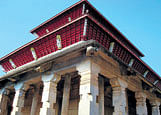Moodabidri, home to Jain architecture

The road meanders through lush fields bordered by coconut and palm trees. The bamboo stalks greet you as a collage of green and blue meets the eye. The rivers alternate with the seas. A hanging bridge appears out of nowhere dangling precariously above the fields. One nondescript hamlet follows another. Occasionally, a noisy town appears and then merges into a dusty village. There is nothing unusual about this journey, except that it is steeped in heritage. We are driving down Dakshina Kannada. Flanked by the Western ghats on one side and the Arabian sea on the other, this picturesque road takes you on a pilgrimage.
A confluence of the spiritual and the historic, this region is dotted with temples and basadis that speak of various rulers, their spiritual beliefs and the art and architecture they left behind for posterity.
We were driving from Kudla, which is the Tulu name for Mangalore meaning junction. Nestled at the confluence of the Netravati and the Gurupura rivers, this port town is the headquarters of the Dakshina Kannada district. A 40-minute drive from here takes us to Moodabidri, the Jain Kashi of the South as it’s called. The noon sun was at its best and the town seemed to be in deep slumber. A seat of Jain culture and architecture, this town has been the seat of several dynasties that promoted Jainism for more than 500 years. A strong testimony to this lies in the basadis or Jain temples which were built here and Moodabidri alone boasts of 18 of them. We wanted to see at least one of them and we decided on a 700-year-old basadi.
Thousand-pillared basadi
A detour from the highway leads us to Tribhuvana Tilaka Chudamani basadi or the crest jewel of the three worlds. It is indeed a jewel of architectural splendour and genius.
The locals and the tourist books refer to it as the thousand pillared temple or the Savira Kambada basadi. It is said to be built by the local ruler, Devaraya Wodeyar in the 15th century and the basadi houses a tall bronze image of Lord Chandranatha Swami, the eighth Tirthankara. The thousand pillared basadi is a three-storey symmetric structure and looks like poetry carved in granite.
A huge wooden carved door opens to a fifty five feet tall single pillar called the Manasthamba that greets us right at the entrance. A couple of ladders are perched here and there. We realise some restoration work has been in progress. There was a deep silence and not a soul was around. I was talking in Tamil when someone from behind asked me in the same language if I wanted a guide. I swirled around in surprise to find Chandra, a local who was once working as a waiter in Chennai. He took over from there and gave me a glimpse into the heritage of Moodabidri and the traditions of Jainism.
The first thing I learnt was that the name Moodabidri was derived from the bamboo that was grown in these parts. Chandra told us that Bidiru meant bamboo and Moodu meant east. For the travellers from west, this thicket of bamboo was Moodabidri. It had royal patronage as it was the capital of the Chowta dynasty who ruled over Tulunadu. They patronised Jainism and even today, a centuries-old palace with beautifully engraved pillars and ornate ceilings stands as a testimony to their reign.
Homage to Jainism
As we enter the portals of the basadi, it opens into a large ornate hall with a beautiful flooring and carved pillars. Chandra points out that the flooring is about 600 years old. The three-storey structure which was patronised by the king was supported by the wealthy merchants and town councillors and still today stands as an epitome of a town’s homage to Jainism.
The monolithic Manasthambha built by Queen Nagala Devi, queen of Bhairava Raja installed at a later date is about fifty five feet feet high. Chandra explains that the word Manasthambha means that a pilgrim gives up his pride and ego before entering the basadi.
We walk around the basadi and see more beautiful sculptures gazing at us from various angles. There are seven mantapas supported by several pillars, all symmetrical. Chandra points out that no two pillars are actually the same.
Each mantapa is supported by a multitude of pillars which have their own unique designs carved in granite.
Elaborately carved figures of chauri-bearers, drummers jostle for space with elephants, giraffes, dragons and tigers. Our guide told us that this was an indication of the trade and relationship between Jain merchants and foreign countries.
The sloping red roof with carved posts in copper and granite with wooden bars create a stark picture against the bright blue sky. Heads of snakes stand out at every corner. The lawns are littered with the belongings of labourers who have taken a lunch break. Chandra takes us inside to see the bronze idol of the deity and a moment lapses in just awe and wonder.
As we sit down on the grass, we realise there are no tourists or pilgrims, just us, Chandra and a few labourers.
Our guide tells us there is more to see in Moodabidri, the ancient monastery, one of the oldest basadis, the 12th century Guru basadi, the Gowri temple...But, that would have to wait. We have a tryst with ancient Jainism.
Getting there
Moodabidri is 37 kms from Mangalore and it is ideal to go on a day trip by road. Buses ply on this route as well.
The main tourist attractions are the Guru basadi, thousand pillared basadi, Chowta palace and the Jain monastery. In most places, you would need to pay some money for photography, though there are not any official boards announcing the same. There are no official guides as well, but locals like Chandra are a plenty.
Deccan Herald is on WhatsApp Channels| Join now for Breaking News & Editor's Picks